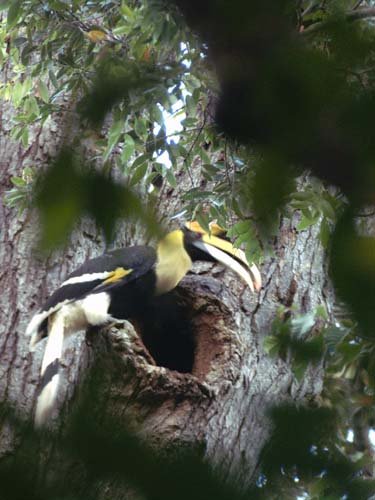January 2007
Peering through my monocular, I can see its eyes are red a
sure indicator that it’s a male and on the branch above it his mate for
life the female with her yellow eyes and slighter built. (having to see
a bird through a binocular or monocular makes for a whole lot of
difference.) For this is the only way one can tell the difference
between the male and female Great Hornbill.
If there is any bird that deserves the oos! and the aars! on the island it must be these magnificent hornbills.Langkawi is a birders paradise, with lush rainforest covering more than 50 percent of the island and another 30 percent with rice paddy’s, it is home to over 180 species of birds.
Among all the birds, if I had to have a favorite then it must be the Hornbills. The best place on the island to observe them is at Gunung Raya, this protected forest reserve is located at the center of the island and is about a 20minute drive from most hotels along Pantai Cenang. No trip to this island can be complete without checking these birds out, so grab yourself a good map, a pair of binoculars, perhaps a bird book get into your car and drive yourself to the base of Gunung Raya.
Once you are there wind down your windows, switch off your radio, drive slowly, look and listen. Be sure to stop at several places along the way, get out of the car and look for them, paying special attention to any fruiting trees. You would not have to wait too long before you will be rewarded with the sight of these amazing birds.
The Great Hornbill is the largest bird on the island, from the tip of its beak to the tip of its tail it measures at 1.20 meters! Its call is a distinct and loud Gok! Gok! Gok! and sometimes followed with a Gawarrrr! When this bird flies you hear a woosh! like sound with each wing beat it takes.
These birds are monogamous (strange culture! No, no just joking, I mean good culture) they reach maturity at year five and live for about 28 to 30 years. When it is time for her to lay her eggs she will find a hollow in a tree, if the hollow is suitable she enters and begin to plaster herself inside using her own droppings this makes for a wonderful cement to seal herself into her nest. She leaves a small opening to allow her beak to stick out. She has built herself a fortress.
She will remain in this nest for between 8 to 9 weeks. Throughout her stay in this confine quarters the male will travel and return every 2 to 3 hours with room service! Its diet is mostly fruits but some times it is supplemented with little lizards and little snakes and once I saw the male bring her a little squirrel. The female is not having a holiday while the poor male is hard at work , she stays behind to protect her one precious egg from many enemies including large snakes, monitor lizards , macaque monkeys and civet cats.
8 or 9 weeks later when the young is strong, can protect it own self and food needs increase the female will break out and together both parents will feed its young until about 4 or 5 weeks later the young breaks out too and join its parents and be trained for the next 6 months before they join the flock. Hornbills are remarkable parents and they never fail to impress me.
The best times to see these birds are between 7.30am and 10.00am in the morning or between 5.00 pm and 7.00pm in the evening. And as an added reward the drive up Gunung Raya, have some of the most scenic views of the island especially at sunset. Happy birding folks.
[tab][gallery ids="584,586,589,591,594,600,601,602,603,604,605,606,633,639,640,641,642,643,644,645"]
[/tab] 
